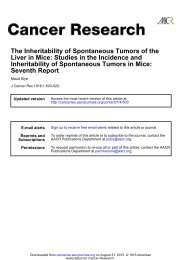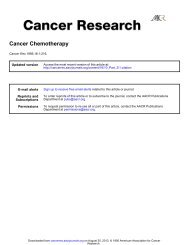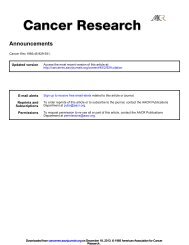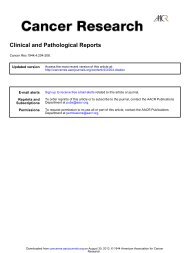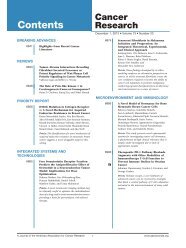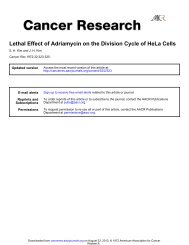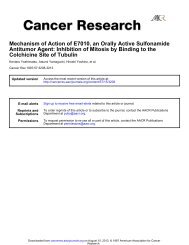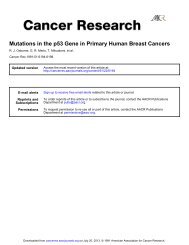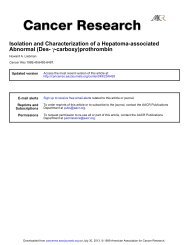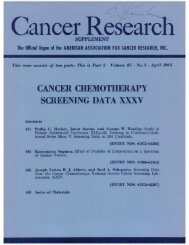Trichothiodystrophy, a Human DNA Repair ... - Cancer Research
Trichothiodystrophy, a Human DNA Repair ... - Cancer Research
Trichothiodystrophy, a Human DNA Repair ... - Cancer Research
Create successful ePaper yourself
Turn your PDF publications into a flip-book with our unique Google optimized e-Paper software.
(CANCER RESEARCH 48, 6090-6096, November 1. 1988]<br />
<strong>Trichothiodystrophy</strong>, a <strong>Human</strong> <strong>DNA</strong> <strong>Repair</strong> Disorder with Heterogeneity in the<br />
Cellular Response to Ultraviolet Light1<br />
Alan R. Lehmann,2 Colin F. Arlett, Bernard C. Broughton, Susan A. Harcourt, Herdis Steingrimsdottir,<br />
Miria Stefanini, A. Malcolm R. Taylor, A. T. Natarajan, Stuart Green, Mary D. King, RoñaM. MacKie,<br />
John B. P. Stephenson, and John L. Tolmie<br />
MRC Cell Mutation Unit, University of Sussex, Fainter, Brighton, Sussex BNI 9RK, United Kingdom [A. R. L., C. F. A., B. C. B., S. A. H., H. S.J; Instituto di Genetica<br />
Biochimica ed Evoluzionistica C/VA, Via Abbiategrasso 207, 1-27100, Pavia, Italy [M. S.j; Department of <strong>Cancer</strong> Studies, Medical School, University of Birmingham,<br />
Birmingham BIS 2TJ, United Kingdom [A. M. R. T.J; Department of Radiation Genetics and Chemical Mutagenesis, University of Leiden, Wassenaarseweg 72,<br />
Leiden, The Netherlands [A. T. N.]; Royal Hospital for Sick Children, Yorkhill, Glasgow, United Kingdom [M. D. K., J. B. P. S.J; Department of Dermatology, University<br />
of Glasgow, 56 Dumbarton Road, Glasgow GII 6NU, United Kingdom fR. M. M.J; Institute of Child Health, Birmingham University, Francis Road, Birmingham BI6<br />
SET, United Kingdom fS. G.J; Duncan Guthrie Institute of Medical Genetics, Yorkhill, Glasgow G3 SSJ, United Kingdom fJ. L. T.J<br />
ABSTRACT<br />
<strong>Trichothiodystrophy</strong> (I'll)) is an autosomal recessive disorder char<br />
acterized by brittle hair with reduced sulfur content, ichthyosis, peculiar<br />
face, and mental and physical retardation. Some patients are photosen<br />
sitive. A previous study by Stefanini et al. (Hum. Genet., 74: 107-112,<br />
1986) showed that cells from four photosensitive patients with I'll) had<br />
a molecular defect in <strong>DNA</strong> repair, which was not complemented by cells<br />
from xeroderma pigmentosum, complementation group D. In a detailed<br />
molecular and cellular study of the effects of UV light on cells cultured<br />
from three further I'll) patients who did not exhibit photosensitivity we<br />
have found an array of different responses. In cells from the first patient,<br />
survival, excision repair, and <strong>DNA</strong> and RNA synthesis following UV<br />
irradiation were all normal, whereas in cells from the second patient all<br />
these responses were similar to those of excision-defective xeroderma<br />
pigmentosum (group D) cells. With the third patient, cell survival meas<br />
ured by colony-forming ability was normal following UV irradiation, even<br />
though repair synthesis was only 50% of normal and RNA synthesis was<br />
severely reduced. The excision-repair defect in these cells was not com<br />
plemented by other I'll) cell strains. These cellular characteristics of<br />
patient 3 have not been described previously for any other cell line. The<br />
normal survival may be attributed to the finding that the deficiency in<br />
excision-repair is i-imfmed to early times after irradiation. Our results<br />
pose a number of questions about the relationship between the molecular<br />
defect in <strong>DNA</strong> repair and the clinical symptoms of xeroderma pigmen<br />
tosum and I'll).<br />
INTRODUCTION<br />
<strong>Trichothiodystrophy</strong> is an autosomal recessive disorder char<br />
acterized by sulfur-deficient brittle hair. Hair shafts split lon<br />
gitudinally into small fibers and this brittleness is associated<br />
with levels of cysteine/cystine in hair proteins which are 15-<br />
50% of those in normal individuals (1-3). The condition is also<br />
accompanied by physical and mental retardation of varying<br />
seventy (1, 3-6). The patients often have an unusual facial<br />
appearance, with protruding ears and a receding chin. Mental<br />
abilities range from low normal to severe retardation. Ichthyosis<br />
(scaling of the skin) has been reported in many of the affected<br />
patients (3, 6-8). The disorder was first recognized by Pollitt<br />
et al. ( l ) and about 20 reports of similar cases have appeared<br />
in the literature. The accompanying symptoms are very heter<br />
ogeneous. Severe photosensitivity has been reported for about<br />
one-half of the patients (e.g., Refs. 3, 7, and 9). Skin cancer has<br />
not been reported in any patient with TTD.3 The condition has<br />
Received 5/3/88: revised 7/25/88; accepted 7/29/88.<br />
The costs of publication of this article were defrayed in part by the payment<br />
of page charges. This article must therefore be hereby marked advertisement in<br />
accordance with 18 U.S.C. Section 1734 solely to indicate this fact.<br />
' This work was supported in part by EC Contracts BI6.042.UK(H) and<br />
BI6.I58.I.<br />
1To whom requests for reprints should be addressed.<br />
1The abbreviations used are: TTD, trichothiodystrophy; CS, Cockayne's syn<br />
drome; SCE, sister chromatid exchange; UDS, unscheduled <strong>DNA</strong> synthesis; XP,<br />
xeroderma pigmentosum.<br />
been reviewed recently by Nuzzo and Stefanini (10).<br />
The association of TTD with a <strong>DNA</strong> repair defect was first<br />
reported briefly by Yong et al. (9) and van Neste et al. (11).<br />
These reports both stated that in cells from photosensitive<br />
patients with TTD there was a defect in excision repair follow<br />
ing UV damage, similar to that observed in patients with<br />
xeroderma pigmentosum. A more extensive study by Stefanini<br />
et al. (7) showed that four Italian patients with TTD and<br />
associated photosensitivity all showed a deficiency in excisionrepair<br />
of UV damage in both lymphocytes and fibroblasts.<br />
Furthermore, cell fusion studies with cells from different XP<br />
complementation groups showed that there was no complemen<br />
tation between TTD cells and those from XP group D. In<br />
contrast an Italian TTD patient without photosensitivity had<br />
no defect in excision-repair (12).<br />
We have carried out a detailed study of the response to UV<br />
light of fibroblasts from three further patients with TTD, and<br />
our results, which show remarkable heterogeneity between pa<br />
tients, are presented in this paper. We find that the cells from<br />
one patient have a completely normal response to UV, whereas<br />
those from a second patient show characteristics of XP-D cells,<br />
like those described by Stefanini et al. (7). The cells from the<br />
third patient show some normal responses, whereas other as<br />
pects are markedly deficient depending on the nature of the<br />
assay.<br />
MATERIALS AND METHODS<br />
Patients. Two of the TTD patients whose cells are used in our<br />
experiments are those described by King et al. (6). Réévaluation of the<br />
clinical data on these patients has revealed that, contrary to previous<br />
suggestions (6), neither of them exhibited any photosensitivity. Cultures<br />
from these patients are correctly designated TTD1GL and TTD2GL,<br />
respectively, but we shall refer to them in this paper, for simplicity, as<br />
PI and P2.<br />
The third strain, TTD1BI (referred to as P3), was from a 6-year-old<br />
boy with brittle hair and trichorrhexis nodosa. His height is 86.5 cm<br />
and weight is 10.7 kg (both below the 3rd percentile), his head circum<br />
ference is 47 cm (also below 3rd percentile). He has a thin face, full<br />
cheeks, stubbly hair and nystagmus with remnants of cataracts which<br />
were removed at 3 months of age. His nails are dysplastic and his skin<br />
is ichthyotic. There are no indications of photosensitivity. Although he<br />
is able to smile, socialize, laugh, and chuckle, he has no real language.<br />
He sits, stands, and manipulates simple toys but does not walk unaided.<br />
At birth he had the characteristic "collodion baby" appearance of the<br />
skin, and he had a slightly abnormal facial appearance with brittle<br />
stubbly hair. In infancy he had many respiratory infections and did not<br />
thrive well, and at age 2 years 10 months he had an attack of severe<br />
abdominal pain for which no cause was found. An attack of measles at<br />
age 4 years was followed by general debility and according to his mother<br />
a regression of development. Progress thereafter has been slow, but he<br />
appears to be stable with no further degeneration.<br />
6090<br />
Downloaded from<br />
cancerres.aacrjournals.org on August 13, 2013. © 1988 American Association for <strong>Cancer</strong><br />
<strong>Research</strong>.




